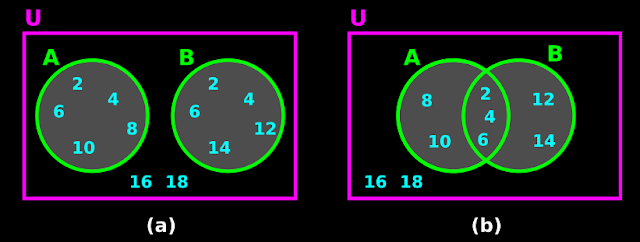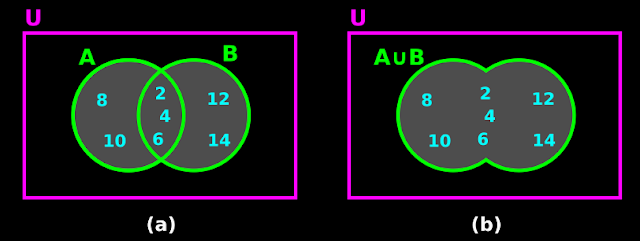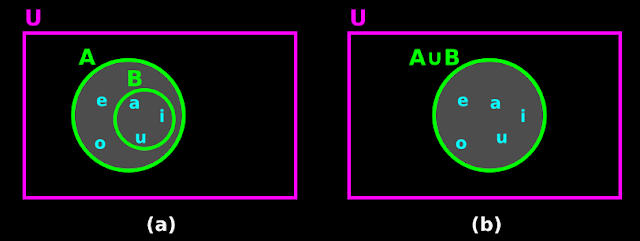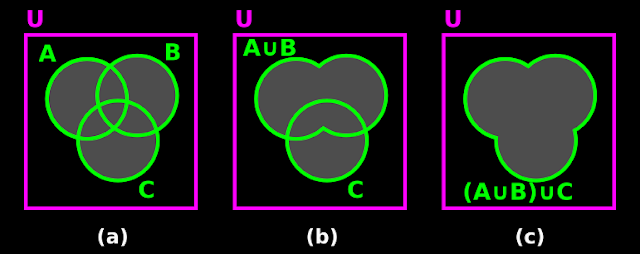In the previous section,
we saw power set and universal set. In this section, we will see Venn diagrams. Later in this section, we will also see union of sets.
• Basics of Venn diagrams can be explained in 3 steps:
1. In Venn diagrams, the universal set is represented by a rectangle.
♦ All other sets are represented by circles.
• We know that, all other sets will be subsets of U.
♦ So the circles are enclosed within the rectangle.
2. In fig.1.4(a) below,
♦ Set A = {2, 4, 6, 8, 10}
♦ Set B = {2, 4, 6, 12, 14}
 |
| Fig.1.4 |
• All elements of A and all elements of B belong to U.
• We see that, both A and B possess 2, 4 and 6.
• So we are inclined to think that, U possess two 2, two 4 and two 6
3. Recall that, in sets, repeating elements are written only once. This is applicable to universal set also.
• So the fig.a must be modified. The modified fig. is shown in fig.1.4(b)
• In the modified fig., we see that,
♦ The two circles over lap.
✰ But the circle A encloses all elements of set A.
✰ Also, the circle B encloses all elements of set B.
• Thus we get:
A = {2, 4, 6, 8, 10}
B = {2, 4, 6, 12, 14}
U = {2, 4, 6, 8, 10, 12, 14, 16, 18}
Operations on sets
• Consider the familiar operation of addition that we perform on two numbers say 5 and 12.
♦ As a result of the operation, we get a new number 17
• Subtraction is another operation that we perform on two numbers.
• We can perform certain operations on sets also.
♦ As a result of such an operation, we get a new set.
• We will now discuss about those operations that we perform between two sets.
Union of sets
• This can be explained in 8 steps:
1. Let A and B be any two sets.
• We perform an operation called ‘union of sets’ between A and B.
2. The set which is formed as a result of that operation,
♦ will contain all the elements of A.
♦ will contain all the elements of B.
3. But there is an important point to remember. It can be written in 3 steps:
(i) Some elements may be present in both the sets A and B.
(ii) So when we write the elements of A and B together, such elements will appear twice.
(iii) However, in the resultant set, those repeating elements should be written only once.
4. The symbol ‘∪’ is used to represent union.
• So the union of A and B can be represented as A ∪ B
5. Let us see some examples:
A = {2, 4, 6, 8, 10} and B = {2, 4, 6, 12, 14}. Find A ∪ B.
Solution:
• A ∪ B must contain all the elements of A and B.
• The elements 2, 4 and 6 appear in both A and B. They must be written only once in A ∪ B.
• Thus we get: A ∪ B = {2, 4, 6, 8, 10, 12, 14}
• We can represent this union using Venn diagrams also.
♦ Fig.1.5(a) below shows A and B before the union.
♦ Fig.1.5(b) shows the new set which is A ∪ B.
 |
| Fig.1.5 |
6. Another example:
Let A = { a, e, i, o, u } and B = { a, i, u }. Show that A ∪ B = A
Solution:
• A ∪ B must contain all the elements of A and B.
• The elements a, i and u appear in both A and B. They must be written only once in A ∪ B.
• Thus we get: A ∪ B = {a, e, i, o, u}
♦ We see that, A ∪ B is same as A.
• We can represent this union using Venn diagrams also.
♦ Fig.1.6(a) below shows A and B before the union.
♦ Fig.1.6(b) shows the new set which is A ∪ B
 |
| Fig.1.6 |
♦ When the union takes place, the resulting set is same as the superset
♦ We can write: B ⊂ A ⇒ A ∪ B = A
7. One more example:
Let X = {Ram, Geeta, Akbar} be the set of students of Class XI, who are in school hockey team. Let Y = {Geeta, David, Ashok} be the set of students from Class XI who are in the school football team. Find X ∪ Y and interpret the set.
Solution:
• We have: X ∪ Y = {Ram, Geeta, Akbar, David, Ashok}
• We see that:
The set X ∪ Y consists of members who are in the hockey team or football team or both
8. Thus we can write the definition:
| Definition 6: The union of two sets A and B is the set C which consists of all those elements which are either in A or in B (including those which are in both). |
• In symbols, we write: A ∪ B = { x : x ∈ A or x ∈ B }
Some Properties of the Operation of Union
1. A ∪ B = B ∪ A (Commutative law)
• This is obvious from fig.1.5 above.
♦ Both A ∪ B and B ∪ A will give the same result in fig.1.5(b)
2. (A ∪ B) ∪ C = A ∪ (B ∪ C) (Associative law)
• This can be proved in 3 steps, using Venn diagrams.
(i) Fig.1.7(a) below shows the three sets A, B and C.
 |
| Fig.1.7 |
• Fig.b shows (A ∪ B) and C.
♦ Fig.c shows the union between (A ∪ B) and C.
(ii) Fig.1.8(a) below shows the three sets A, B and C.
 |
| Fig.1.8 |
♦ Fig.c shows the union between A and (B ∪ C).
(iii) We see that
♦ Fig.1.7(c)
♦ is same as
♦ Fig.1.8(c)
3. A ∪ ɸ = A (Law of identity element, ɸ is the identity of ∪)
• This is obvious because,
♦ A ∪ ɸ must contain all elements of A and ɸ.
♦ That means, A ∪ ɸ will contain only the elements of A.
4. A ∪ A = A (Idempotent law)
• This is obvious because,
♦ A ∪ A must contain all elements of A and A.
♦ But we know that, repeating elements are written only once.
♦ That means, A ∪ A will contain only the elements of A.
(5) U ∪ A = U (Law of U)
• This is obvious because,
♦ U ∪ A must contain all elements of U and A.
♦ U already contains A.
♦ But we know that, repeating elements are written only once.
♦ That means, U ∪ A will be same as U.
In the next
section, we will see intersection of sets
Previous
Contents
Next
Copyright©2021 Higher secondary mathematics.blogspot.com
No comments:
Post a Comment